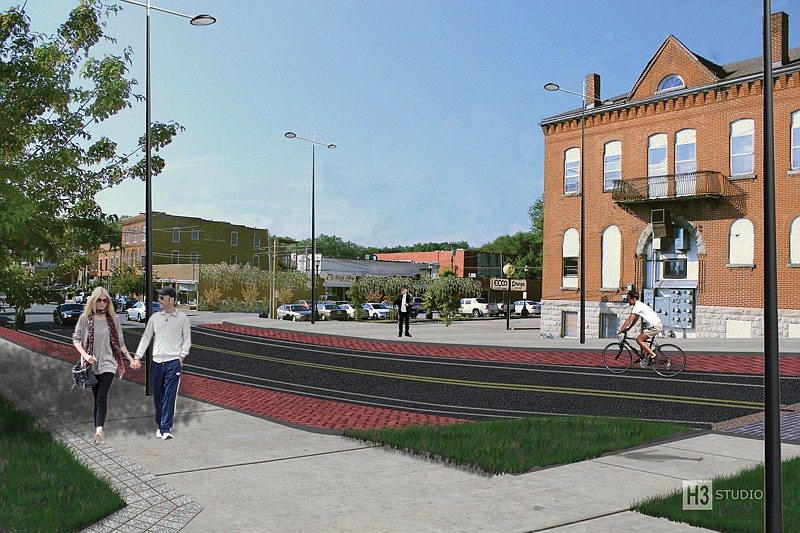The Jefferson City Council postponed voting on a plan to revitalize the historic southside neighborhood at Tuesday's meeting.
The Historic Southside/Old Munichburg District and Neighborhood Plan would be a component of the city's Comprehensive Plan. It calls for rezoning several areas in the neighborhood, improving roads and interchanges, encouraging more developments and creating new parks.
City Counselor Ryan Moehlman said postponing the vote will allow the city's legal department to research how the City Council approaches making amendments to the city's Comprehensive Plan. Jefferson City Mayor Carrie Tergin said postponing the vote will not impact anything in the historic southside plan.
It is unknown when the City Council will vote on it.
The plan came after Capital Region Medical Center invested $37 million in a 2014 expansion project. CRMC President Gaspare Calvaruso told the News Tribune the hospital started looking at ways to improve the surrounding neighborhoods and hired H3 Studio about two years ago to create a redevelopment plan. A St. Louis firm, H3 Studio held several workshops and meetings through 2015-16 to hear comments from residents, businesses and stakeholders.
Janet Weckenborg, vice president of operations at CRMC, said the plan emphasizes the community's strengths and addresses any weaknesses.
"(The plan) really took into account the assets this community has and the struggles (it) also has," she said.
According to the plan, there were more than 2,100 housing units; about 14 percent of the homes were unoccupied and 20 percent of the buildings were in poor condition. The area also had streets and sidewalks in poor condition.
The southside neighborhood also had a 9 percent unemployment rate at the time the October 2016 plan was published, almost three times higher than the Jefferson City unemployment rate at the time.
The average income for the neighborhood is $17,608, compared to the city average of $24,763, according to the U.S. Census Bureau. The median income in the area is $41,250 while the city's median income is $47,969, the U.S. Census Bureau states.
The plan contains 10 goals, spread out in four phases over 20 years. One of the first goals is to develop the U.S. 50 corridor so it connects the historic southside to downtown Jefferson City. This involves making it more pedestrian- and bicycle-friendly.
Other goals include revitalizing the area around Dunklin Street, reconfiguring several streets and developing a home repair program. The plan also calls for the expansion of Washington Park and for the city to buy some vacant and dilapidated properties in flood-prone areas to turn into parks.
One of the final goals is to redesign the Stadium Boulevard and U.S. 54 intersection by constructing at least three roundabouts to re-route traffic. Madison Street would be disconnected from U.S. 54 and re-routed, but drivers could still access Madison Street from U.S. 54 via Stadium.
The U.S. 54 interchange is currently flawed, according to the plan. Improving this section could improve traffic flow and lead to future redevelopment.
City Senior Planner Eric Barron said if the plan is approved by the City Council, creating a community development corporation would be the next step. A CDC is a nonprofit organization that supports and implements aspects of the plan.
Calvaruso said public funds would not be used to fund a CDC. Instead, local businesses and groups are investigating ways to support the CDC through direct funding and grants.
St. Mary's Hospital TIF Plan
The City Council approved activating the tax increment financing ordinance for the old St. Mary's Hospital redevelopment project during Tuesday's meeting. The project - proposed by Farmer Holding Company - was approved Aug. 21, but under state law, the council had to pass a separate ordinance activating the TIF within 90 days of the project approval.
Project developer F&F Development requested the council vote on the TIF activation ordinance at Tuesday's meeting.
"They see this as a button that needs to be buttoned up, so they would rather take care of this now rather than later," Moehlman said.
Farmer Holding proposed two projects to redevelop the former St. Mary's Hospital. One project - estimated at $44.6 million - would involve partnering with Lincoln University and using parts of the old hospital for the university's nursing program or other programs. The project would also have four retail pads with 21,000 square feet of commercial space.
The second plan, if Farmer Holding is not able to partner with the university, is to construct six pads with 30,200 feet of commercial space for an estimated $30.9 million.

